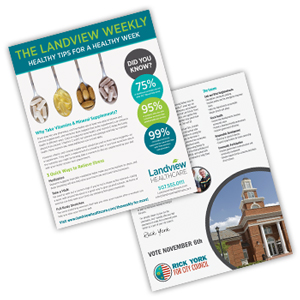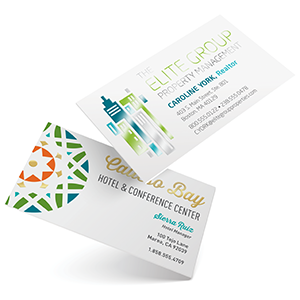Your customers come to you for a lot of different reasons. Maybe they need business cards for an upcoming event. Maybe they have to create a brochure for a new product. Maybe they want folders to keep organized at their business. However, if your customers are ordering their stationery pieces individually, they might not be taking advantage of the benefits that can come from coordinating their print pieces with each other.
Make Their Business Look More Put-Together
This is the biggest reason for your customers to coordinate their print pieces. When their print pieces look coordinated, it makes their entire business look a little more polished and organized by extension. This starts with their more traditional pieces, of course—a well-matched stationery set is the foundation of professional corporate communications.
Your customer can also extend this idea to other pieces. From keeping offices organized to presenting ideas to customers, branded folders can add a special touch to your customer’s print order. When the time comes for your customers to send out announcements for company news or invitations for their next big event, creating announcements that coordinate with their existing stationery can be a great way of ensuring the event feels connected to your customer’s brand. And when your customer matches their brochures, sales sheets, and rack cards to their other print pieces, it will make sure your customer’s brand is top of mind when their clients think of the new products and services that those print pieces promoted.
Create the Right Mood with Every Print Piece
When your customer coordinates all of their print pieces, it ensures that every piece creates the right feel. After all, once your customer has chosen a business card stock that conveys quality or a print process that creates just the right look for their brand, it’s easy to create that same feel by matching other pieces to that business card.
That doesn’t mean they all have to look exactly alike, though. By using an accent color, on the other hand, your customer’s stationery suite will continue to look cohesive but have a more varied, creative look. This is an ideal option for customers who want to convey a lively, friendly, or artistic personality with their print pieces.
Make Your Customer’s Brand Instantly Recognizable
The more your customer’s brand is seen, the bigger the benefits for their business. This means that every piece of print that they send out—from the branded business envelope that holds an invoice to the business card that accompanies a sales representative to an official meeting—is a chance for one more impression. Not only does this make your customer’s brand more recognizable, it keeps their brand top of mind for their clients.
What are your customer’s favorite print pieces? We’d love to see you join the conversation in the comments below.
 When your customer is creating an informational flyer, a sales sheet for meetings, or a company newsletter, it’s important that their design guides readers through the information and makes it easy—and enticing—to take the next step. If they come to you for guidance on designing their sales sheets, it’s important that you know how to make their sales sheet effective. Here are our tips for designing a better
When your customer is creating an informational flyer, a sales sheet for meetings, or a company newsletter, it’s important that their design guides readers through the information and makes it easy—and enticing—to take the next step. If they come to you for guidance on designing their sales sheets, it’s important that you know how to make their sales sheet effective. Here are our tips for designing a better  When you carve out time in your busy schedule to hold a meeting, you want to make sure you use your time effectively and make the most of your time together. However, if you aren’t communicating well, you might be ruining your meetings. Are you making these mistakes—and do you know how to keep them from ruining your meetings?
When you carve out time in your busy schedule to hold a meeting, you want to make sure you use your time effectively and make the most of your time together. However, if you aren’t communicating well, you might be ruining your meetings. Are you making these mistakes—and do you know how to keep them from ruining your meetings? Whether you are looking for a way to connect with new customers or you’re hoping to have a good conversation with other professionals, a networking event could be a great way to create those new connections. However, these events are what you make them, and creating a quality connection is as much about your skills at networking as it is about the event. Here are four networking tips you must know.
Whether you are looking for a way to connect with new customers or you’re hoping to have a good conversation with other professionals, a networking event could be a great way to create those new connections. However, these events are what you make them, and creating a quality connection is as much about your skills at networking as it is about the event. Here are four networking tips you must know. Are your customers looking for a way to add polish to their business cards to make a more memorable first impression? Do they want to make their announcements for an upcoming event extra-special? Do they want the postcard for their next mailing to be truly showstopping?
Are your customers looking for a way to add polish to their business cards to make a more memorable first impression? Do they want to make their announcements for an upcoming event extra-special? Do they want the postcard for their next mailing to be truly showstopping?